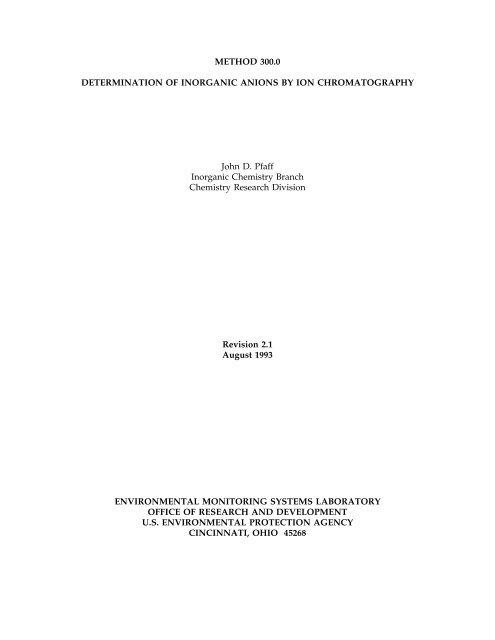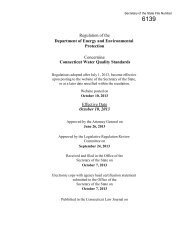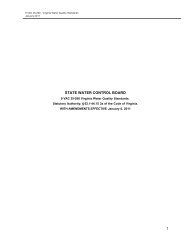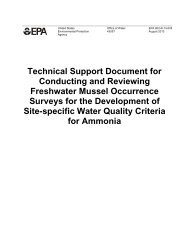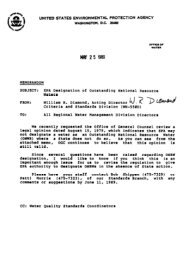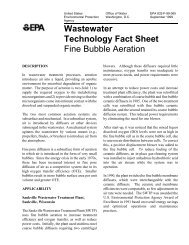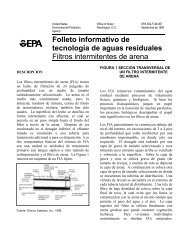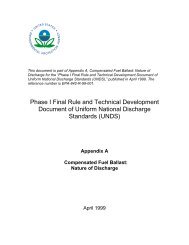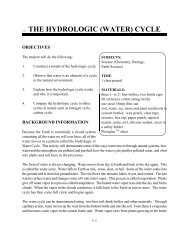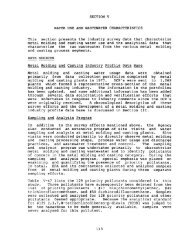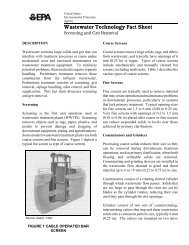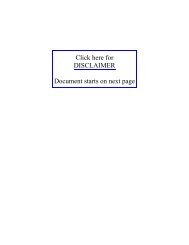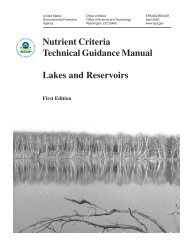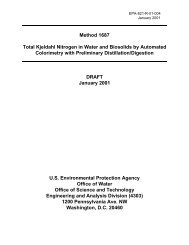Method 300.0, Rev. 2.1 - Water - US Environmental Protection Agency
Method 300.0, Rev. 2.1 - Water - US Environmental Protection Agency
Method 300.0, Rev. 2.1 - Water - US Environmental Protection Agency
Create successful ePaper yourself
Turn your PDF publications into a flip-book with our unique Google optimized e-Paper software.
METHOD <strong>300.0</strong><br />
DETERMINATION OF INORGANIC ANIONS BY ION CHROMATOGRAPHY<br />
John D. Pfaff<br />
Inorganic Chemistry Branch<br />
Chemistry Research Division<br />
<strong>Rev</strong>ision <strong>2.1</strong><br />
August 1993<br />
ENVIRONMENTAL MONITORING SYSTEMS LABORATORY<br />
OFFICE OF RESEARCH AND DEVELOPMENT<br />
U.S. ENVIRONMENTAL PROTECTION AGENCY<br />
CINCINNATI, OHIO 45268
METHOD <strong>300.0</strong><br />
DETERMINATION OF INORGANIC ANIONS BY ION CHROMATOGRAPHY<br />
1.0 SCOPE AND APPLICATION<br />
1.1 This method covers the determination of the following inorganic anions:<br />
PART A.<br />
Bromide Nitrite<br />
Chloride Ortho-Phosphate-P<br />
Fluoride Sulfate<br />
Nitrate<br />
PART B.<br />
Bromate Chlorite<br />
Chlorate<br />
1.2 The matrices applicable to each method are shown below:<br />
1.<strong>2.1</strong> Drinking water, surface water, mixed domestic and industrial<br />
wastewaters, groundwater, reagent waters, solids (after extraction 11.7),<br />
leachates (when no acetic acid is used).<br />
1.2.2 Drinking water and reagent waters<br />
1.3 The single laboratory <strong>Method</strong> Detection Limit (MDL defined in Section 3.2) for<br />
the above analytes is listed in Tables 1A and 1B. The MDL for a specific<br />
matrix may differ from those listed, depending upon the nature of the sample.<br />
1.4 <strong>Method</strong> A is recommended for drinking and wastewaters. The multilaboratory<br />
ranges tested for each anion are as follows:<br />
Analyte mg/L<br />
Bromide 0.63 - 21.0<br />
Chloride 0.78 - 26.0<br />
Fluoride 0.26 - 8.49<br />
Nitrate-N 0.42 - 14.0<br />
Nitrite-N 0.36 - 12.0<br />
Otho-Phosphate-P 0.69 - 23.1<br />
Sulfate 2.85 - 95.0<br />
1.5 This method is recommended for use only by or under the supervision of<br />
analysts experienced in the use of ion chromatography and in the<br />
interpretation of the resulting ion chromatograms.
1.6 When this method is used to analyze unfamiliar samples for any of the above<br />
anions, anion identification should be supported by the use of a fortified<br />
sample matrix covering the anions of interest. The fortification procedure is<br />
described in Section 11.6.<br />
1.7 Users of the method data should state the data-quality objectives prior to<br />
analysis. Users of the method must demonstrate the ability to generate<br />
acceptable results with this method, using the procedures described in<br />
Section 9.0.<br />
2.0 SUMMARY OF METHOD<br />
<strong>2.1</strong> A small volume of sample, typically 2-3 mL, is introduced into an ion<br />
chromatograph. The anions of interest are separated and measured, using a<br />
system comprised of a guard column, analytical column, suppressor device,<br />
and conductivity detector.<br />
2.2 The main differences between Parts A and B are the separator columns and<br />
guard columns. Sections 6.0 and 7.0 will elicit the differences.<br />
2.3 An extraction procedure must be performed to use this method for solids<br />
(See Section 11.7).<br />
2.4 Limited performance-based method modifications may be acceptable provided<br />
they are fully documented and meet or exceed requirements expressed in<br />
Section 9.0, Quality Control.<br />
3.0 DEFINITIONS<br />
3.1 Calibration Blank (CB) -- A volume of reagent water fortified with the same<br />
matrix as the calibration standards, but without the analytes, internal<br />
standards, or surrogate analytes.<br />
3.2 Calibration Standard (CAL) -- A solution prepared from the primary dilution<br />
standard solution or stock standard solutions and the internal standards and<br />
surrogate analytes. The CAL solutions are used to calibrate the instrument<br />
response with respect to analyte concentration.<br />
3.3 Field Duplicates (FD) -- Two separate samples collected at the same time and<br />
placed under identical circumstances and treated exactly the same throughout<br />
field and laboratory procedures. Analyses of field duplicates indicate the<br />
precision associated with sample collection, preservation and storage, as well<br />
as with laboratory procedures.<br />
3.4 Instrument Performance Check Solution (IPC) -- A solution of one or more<br />
method analytes, surrogates, internal standards, or other test substances used<br />
to evaluate the performance of the instrument system with respect to a defined<br />
set of criteria.
3.5 Laboratory Fortified Blank (LFB) -- An aliquot of reagent water or other blank<br />
matrices to which known quantities of the method analytes are added in the<br />
laboratory. The LFB is analyzed exactly like a sample, and its purpose is to<br />
determine whether the methodology is in control, and whether the laboratory<br />
is capable of making accurate and precise measurements.<br />
3.6 Laboratory Fortified Sample Matrix (LFM) -- An aliquot of an environmental<br />
sample to which known quantities of the method analytes are added in the<br />
laboratory. The LFM is analyzed exactly like a sample, and its purpose is to<br />
determine whether the sample matrix contributes bias to the analytical results.<br />
The background concentrations of the analytes in the sample matrix must be<br />
determined in a separate aliquot and the measured values in the LFM<br />
corrected for background concentrations.<br />
3.7 Laboratory Reagent Blank (LRB) -- An aliquot of reagent water or other blank<br />
matrices that are treated exactly as a sample including exposure to all<br />
glassware, equipment, solvents, reagents, internal standards, and surrogates<br />
that are used with other samples. The LRB is used to determine if method<br />
analytes or other interferences are present in the laboratory environment, the<br />
reagents, or the apparatus.<br />
3.8 Linear Calibration Range (LCR) -- The concentration range over which the<br />
instrument response is linear.<br />
3.9 Material Safety Data Sheet (MSDS) -- Written information provided by<br />
vendors concerning a chemical's toxicity, health hazards, physical properties,<br />
fire, and reactivity data including storage, spill, and handling precautions.<br />
3.10 <strong>Method</strong> Detection Limit (MDL) -- The minimum concentration of an analyte<br />
that can be identified, measured and reported with 99% confidence that the<br />
analyte concentration is greater than zero.<br />
3.11 Performance Evaluation Sample (PE) -- A solution of method analytes<br />
distributed by the Quality Assurance Research Division (QARD),<br />
<strong>Environmental</strong> Monitoring Systems Laboratory (EMSL-Cincinnati), U. S.<br />
<strong>Environmental</strong> <strong>Protection</strong> <strong>Agency</strong>, Cincinnati, Ohio, to multiple laboratories for<br />
analysis. A volume of the solution is added to a known volume of reagent<br />
water and analyzed with procedures used for samples. Results of analyses are<br />
used by QARD to determine statistically the accuracy and precision that can be<br />
expected when a method is performed by a competent analyst. Analyte true<br />
values are unknown to the analyst.<br />
3.12 Quality Control Sample (QCS) -- A solution of method analytes of known<br />
concentrations that is used to fortify an aliquot of LRB or sample matrix. The<br />
QCS is obtained from a source external to the laboratory and different from<br />
the source of calibration standards. It is used to check laboratory performance<br />
with externally prepared test materials.
3.13 Stock Standard Solution (SSS) -- A concentrated solution containing one or<br />
more method analytes prepared in the laboratory using assayed reference<br />
materials or purchased from a reputable commercial source.<br />
4.0 INTERFERENCES<br />
4.1 Interferences can be caused by substances with retention times that are similar<br />
to and overlap those of the anion of interest. Large amounts of an anion can<br />
interfere with the peak resolution of an adjacent anion. Sample dilution<br />
and/or fortification can be used to solve most interference problems associated<br />
with retention times.<br />
4.2 The water dip or negative peak that elutes near, and can interfere with, the<br />
fluoride peak can usually be eliminated by the addition of the equivalent of 1<br />
mL of concentrated eluent (7.3 100X) to l00 mL of each standard and sample.<br />
4.3 <strong>Method</strong> interferences may be caused by contaminants in the reagent water,<br />
reagents, glassware, and other sample processing apparatus that lead to<br />
discrete artifacts or elevated baseline in ion chromatograms.<br />
4.4 Samples that contain particles larger than 0.45 microns and reagent solutions<br />
that contain particles larger than 0.20 microns require filtration to prevent<br />
damage to instrument columns and flow systems.<br />
4.5 Any anion that is not retained by the column or only slightly retained will<br />
elute in the area of fluoride and interfere. Known coelution is caused by<br />
carbonate and other small organic anions. At concentrations of fluoride above<br />
1.5 mg/L, this interference may not be significant, however, it is the<br />
responsibility of the user to generate precision and accuracy information in<br />
each sample matrix.<br />
4.6 The acetate anion elutes early during the chromatographic run. The retention<br />
times of the anions also seem to differ when large amounts of acetate are<br />
present. Therefore, this method is not recommended for leachates of solid<br />
samples when acetic acid is used for pH adjustment.<br />
4.7 The quantitation of unretained peaks should be avoided, such as low<br />
molecular weight organic acids (formate, acetate, propionate etc.) which are<br />
conductive and coelute with or near fluoride and would bias the fluoride<br />
quantitation in some drinking and most waste waters.<br />
4.8 Any residual chlorine dioxide present in the sample will result in the<br />
formation of additional chlorite prior to analysis. If any concentration of<br />
chlorine dioxide is suspected in the sample purge the sample with an inert gas<br />
(argon or nitrogen) for about five minutes or until no chlorine dioxide remains.<br />
5.0 SAFETY
5.1 The toxicity or carcinogenicity of each reagent used in this method have not<br />
been fully established. Each chemical should be regarded as a potential health<br />
hazard and exposure should be as low as reasonably achievable. Cautions are<br />
included for known extremely hazardous materials or procedures.<br />
5.2 Each laboratory is responsible for maintaining a current awareness file of<br />
OSHA regulations regarding the safe handling of the chemicals specified in<br />
this method. A reference file of Material Safety Data Sheets (MSDS) should be<br />
made available to all personnel involved in the chemical analysis. The<br />
preparation of a formal safety plan is also advisable.<br />
5.3 The following chemicals have the potential to be highly toxic or hazardous,<br />
consult MSDS.<br />
5.3.1 Sulfuric acid (Section 7.4)<br />
6.0 EQUIPMENT AND SUPPLIES<br />
6.1 Balance -- Analytical, capable of accurately weighing to the nearest 0.000l g.<br />
6.2 Ion chromatograph -- Analytical system complete with ion chromatograph and<br />
all required accessories including syringes, analytical columns, compressed<br />
gasses and detectors.<br />
6.<strong>2.1</strong> Anion guard column: A protector of the separator column. If omitted<br />
from the system the retention times will be shorter. Usually packed<br />
with a substrate the same as that in the separator column.<br />
6.2.2 Anion separator column: This column produces the separation shown<br />
in Figures 1 and 2.<br />
6.2.<strong>2.1</strong> Anion analytical column (<strong>Method</strong> A): The separation shown in Figure<br />
1 was generated using a Dionex AS4A column (P/N 37041). An<br />
optional column may be used if comparable resolution of peaks is<br />
obtained, and the requirements of Section 9.2 can be met.<br />
6.2.2.2 Anion analytical column (<strong>Method</strong> B): The separation shown in Figure 2<br />
was generated using a Dionex AS9 column (P/N 42025). An optional<br />
column may be used if comparable resolution of peaks is obtained and<br />
the requirements of Section 9.2 can be met.<br />
6.2.3 Anion suppressor device: The data presented in this method were<br />
generated using a Dionex anion micro membrane suppressor<br />
(P/N 37106).<br />
6.2.4 Detector -- Conductivity cell: Approximately 1.25 µL internal volume,<br />
(Dionex, or equivalent) capable of providing data as required in<br />
Section 9.2.
6.3 The Dionex AI-450 Data Chromatography Software was used to generate all<br />
the data in the attached tables. Systems using a stripchart recorder and<br />
integrator or other computer based data system may achieve approximately<br />
the same MDL's but the user should demonstrate this by the procedure<br />
outlined in Section 9.2.<br />
7.0 REAGENTS AND STANDARDS<br />
7.1 Sample bottles: Glass or polyethylene of sufficient volume to allow replicate<br />
analyses of anions of interest.<br />
7.2 Reagent water: Distilled or deionized water, free of the anions of interest.<br />
<strong>Water</strong> should contain particles no larger than 0.20 microns.<br />
7.3 Eluent solution (<strong>Method</strong> A and <strong>Method</strong> B): Sodium bicarbonate<br />
(CASRN 144-55-8) 1.7 mM, sodium carbonate (CASRN 497-19-8) 1.8 mM.<br />
Dissolve 0.2856 g sodium bicarbonate (NaHCO 3)<br />
and 0.3816 g of sodium<br />
carbonate (Na2CO 3)<br />
in reagent water (Section 7.2) and dilute to 2 L.<br />
7.4 Regeneration solution (micro membrane suppressor): Sulfuric acid<br />
(CASRN-7664-93-9) 0.025N. Dilute 2.8 mL conc. sulfuric acid (H2SO 4)<br />
to 4 L<br />
with reagent water.<br />
7.5 Stock standard solutions, l000 mg/L (1 mg/mL): Stock standard solutions<br />
may be purchased as certified solutions or prepared from ACS reagent grade<br />
materials (dried at 105°C for 30 minutes) as listed below.<br />
-<br />
7.5.1 Bromide (Br ) 1000 mg/L: Dissolve 1.2876 g sodium bromide (NaBr,<br />
CASRN 7647-15-6) in reagent water and dilute to 1 L.<br />
-<br />
7.5.2 Bromate (BrO 3 ) 1000 mg/L: Dissolve 1.1798g of sodium bromate<br />
(NaBrO 3,<br />
CASRN 7789-38-0) in reagent water and dilute to 1 L.<br />
-<br />
7.5.3 Chlorate (Cl0 3 ) 1000 mg/L: Dissolve 1.2753g of sodium chlorate<br />
(NaC10 3,<br />
CASRN 7775-09-9) in reagent water and dilute to 1 L.<br />
-<br />
7.5.4 Chloride (Cl ) l000 mg/L: Dissolve 1.6485 g sodium chloride (NaCl,<br />
CASRN 7647-l4-5) in reagent water and dilute to 1 L.<br />
-<br />
7.5.5 Chlorite (Cl0 2 ) 1000 mg/L: Dissolve 1.3410g of sodium chlorite<br />
(NaC10 2,<br />
CASRN 7758-19-2) in reagent water and dilute to 1 L.<br />
-<br />
7.5.6 Fluoride (F ) 1000 mg/L: Dissolve 2.2100g sodium fluoride (NaF,<br />
CASRN 7681-49-4) in reagent water and dilute to 1 L.<br />
-<br />
7.5.7 Nitrate (NO 3-N) 1000 mg/L: Dissolve 6.0679 g sodium nitrate (NaNO 3 ,<br />
CASRN 7631-99-4) in reagent water and dilute to 1 L.<br />
7.5.8 Nitrite (NO -N) 1000 mg/L: Dissolve 4.9257 g sodium nitrite (NaNO ,<br />
-<br />
2 2<br />
CASRN 7632-00-0) in reagent water and dilute to 1 L.
=<br />
7.5.9 Phosphate (PO 4-P)<br />
1000 mg/L: Dissolve 4.3937 g potassium phosphate<br />
(KH2PO 4,<br />
CASRN 7778-77-0) in reagent water and dilute to 1 L.<br />
=<br />
7.5.10 Sulfate (SO 4 ) 1000 mg/L: Dissolve 1.8141 g potassium sulfate (K2 SO 4 ,<br />
CASRN 7778-80-5) in reagent water and dilute to 1 L.<br />
Note: Stability of standards: Stock standards (7.5) are stable for at<br />
least one month when stored at 4°C. Except for the chlorite standard<br />
which is only stable for two weeks. Dilute working standards should<br />
be prepared weekly, except those that contain nitrite and phosphate<br />
should be prepared fresh daily.<br />
7.6 Ethylenediamine preservation solution: Dilute 10 mL of ethylenediamine (99%)<br />
(CASRN 107-15-3) to 200 mL with reagent water. Use 1 mL of this dilution to<br />
each 1 L of sample taken.<br />
8.0 SAMPLE COLLECTION, PRESERVATION AND STORAGE<br />
8.1 Samples should be collected in plastic or glass bottles. All bottles must be<br />
thoroughly cleaned and rinsed with reagent water. Volume collected should<br />
be sufficient to insure a representative sample, allow for replicate analysis, if<br />
required, and minimize waste disposal.<br />
8.2 Sample preservation and holding times for the anions that can be determined<br />
by this method are as follows:<br />
Analyte Preservation Holding Time<br />
Bromate None required 28 days<br />
Bromide None required 28 days<br />
Chlorate None required 28 days<br />
Chloride None required 28 days<br />
Chlorite Cool to 4°C immediately<br />
Fluoride None required 28 days<br />
Nitrate-N Cool to 4°C 48 hours<br />
Combined<br />
(Nitrate/Nitrite)<br />
conc. H2SO4 to a pH
e cooled to 4°C and held for no longer than 28 days for <strong>Method</strong> A and<br />
analyzed immediately in <strong>Method</strong> B.<br />
Note: If the sample cannot be analyzed for chlorite within ≤10 minutes, the<br />
sample may be preserved by adding 1 mL of the ethylenediamine (EDA)<br />
preservation solution (Section 7.6) to 1 L of sample. This will preserve the<br />
concentration of the chlorite for up to 14 days. This addition of EDA has no<br />
effect on bromate or chlorate, so they can also be determined in a sample<br />
preserved with EDA. Residual chlorine dioxide should be removed from the<br />
sample (per Section 4.8) prior to the addition of EDA.<br />
9.0 QUALITY CONTROL<br />
9.1 Each laboratory using this method is required to operate a formal quality<br />
control (QC) program. The minimum requirements of this program consist of<br />
an initial demonstration of laboratory capability, and the periodic analysis of<br />
laboratory reagent blanks, fortified blanks and other laboratory solutions as a<br />
continuing check on performance. The laboratory is required to maintain<br />
performance records that define the quality of the data that are generated.<br />
9.2 INITIAL DEMONSTRATION OF PERFORMANCE<br />
9.<strong>2.1</strong> The initial demonstration of performance is used to characterize<br />
instrument performance (determination of LCRs and analysis of QCS)<br />
and laboratory performance (determination of MDLs) prior to<br />
performing analyses by this method.<br />
9.2.2 Linear Calibration Range (LCR) -- The LCR must be determined<br />
initially and verified every six months or whenever a significant change<br />
in instrument response is observed or expected. The initial<br />
demonstration of linearity must use sufficient standards to insure that<br />
the resulting curve is linear. The verification of linearity must use a<br />
minimum of a blank and three standards. If any verification data<br />
exceeds the initial values by ±10%, linearity must be reestablished. If<br />
any portion of the range is shown to be nonlinear, sufficient standards<br />
must be used to clearly define the nonlinear portion.<br />
9.2.3 Quality Control Sample (QCS) -- When beginning the use of this<br />
method, on a quarterly basis or as required to meet data-quality needs,<br />
verify the calibration standards and acceptable instrument performance<br />
with the preparation and analyses of a QCS. If the determined<br />
concentrations are not within ±10% of the stated values, performance of<br />
the determinative step of the method is unacceptable. The source of<br />
the problem must be identified and corrected before either proceeding<br />
with the initial determination of MDLs or continuing with on-going<br />
analyses.<br />
9.2.4 <strong>Method</strong> Detection Limit (MDL) -- MDLs must be established for all<br />
analytes, using reagent water (blank) fortified at a concentration of two
(6)<br />
to three times the estimated instrument detection limit. To determine<br />
MDL values, take seven replicate aliquots of the fortified reagent water<br />
and process through the entire analytical method. Perform all<br />
calculations defined in the method and report the concentration values<br />
in the appropriate units. Calculate the MDL as follows:<br />
where, t = Student's t value for a 99% confidence level<br />
and a standard deviation estimate with n-1<br />
degrees of freedom [t= 3.14 for seven replicates]<br />
S = standard deviation of the replicate analyses<br />
MDLs should be determined every six months, when a new operator<br />
begins work or whenever there is a significant change in the<br />
background or instrument response.<br />
9.3 ASSESSING LABORATORY PERFORMANCE<br />
9.3.1 Laboratory Reagent Blank (LRB) -- The laboratory must analyze at least<br />
one LRB with each batch of samples. Data produced are used to assess<br />
contamination from the laboratory environment. Values that exceed the<br />
MDL indicate laboratory or reagent contamination should be suspected<br />
and corrective actions must be taken before continuing the analysis.<br />
9.3.2 Laboratory Fortified Blank (LFB) -- The laboratory must analyze at least<br />
one LFB with each batch of samples. Calculate accuracy as percent<br />
recovery (Section 9.4.2). If the recovery of any analyte falls outside the<br />
required control limits of 90-110%, that analyte is judged out of control,<br />
and the source of the problem should be identified and resolved before<br />
continuing analyses.<br />
9.3.3 The laboratory must use LFB analyses data to assess laboratory<br />
performance against the required control limits of 90-110%. When<br />
sufficient internal performance data become available (usually a<br />
minimum of 20-30 analyses), optional control limits can be developed<br />
from the percent mean recovery (x) and the standard deviation (S) of<br />
the mean recovery. These data can be used to establish the upper and<br />
lower control limits as follows:<br />
UPPER CONTROL LIMIT = x + 3S<br />
LOWER CONTROL LIMIT = x - 3S<br />
The optional control limits must be equal to or better than the required<br />
control limits of 90-110%. After each five to 10 new recovery<br />
measurements, new control limits can be calculated using only the most<br />
recent 20-30 data points. Also, the standard deviation (S) data should
e used to establish an on-going precision statement for the level of<br />
concentrations included in the LFB. These data must be kept on file<br />
and be available for review.<br />
9.3.4 Instrument Performance Check Solution (IPC) -- For all determinations<br />
the laboratory must analyze the IPC (a mid-range check standard) and<br />
a calibration blank immediately following daily calibration, after every<br />
tenth sample (or more frequently, if required) and at the end of the<br />
sample run. Analysis of the IPC solution and calibration blank<br />
immediately following calibration must verify that the instrument is<br />
within ±10% of calibration. Subsequent analyses of the IPC solution<br />
must verify the calibration is still within ±10%. If the calibration cannot<br />
be verified within the specified limits, reanalyze the IPC solution. If the<br />
second analysis of the IPC solution confirms calibration to be outside<br />
the limits, sample analysis must be discontinued, the cause determined<br />
and/or in the case of drift, the instrument recalibrated. All samples<br />
following the last acceptable IPC solution must be reanalyzed. The<br />
analysis data of the calibration blank and IPC solution must be kept on<br />
file with the sample analyses data.<br />
9.4 ASSESSING ANALYTE RECOVERY AND DATA QUALITY<br />
9.4.1 Laboratory Fortified Sample Matrix (LFM) -- The laboratory must add a<br />
known amount of analyte to a minimum of 10% of the routine samples.<br />
In each case the LFM aliquot must be a duplicate of the aliquot used<br />
for sample analysis. The analyte concentration must be high enough to<br />
be detected above the original sample and should not be less than four<br />
times the MDL. The added analyte concentration should be the same<br />
as that used in the laboratory fortified blank.<br />
9.4.1.1 If the concentration of fortification is less than 25% of the<br />
background concentration of the matrix the matrix recovery<br />
should not be calculated.<br />
9.4.2 Calculate the percent recovery for each analyte, corrected for<br />
concentrations measured in the unfortified sample, and compare these<br />
values to the designated LFM recovery range 90-110%. Percent<br />
recovery may be calculated using the following equation:<br />
where, R = percent recovery<br />
C s = fortified sample concentration<br />
C = sample background concentration<br />
s = concentration equivalent of analyte added to sample
9.4.3 Until sufficient data becomes available (usually a minimum of 20-30<br />
analysis), assess laboratory performance against recovery limits for<br />
<strong>Method</strong> A of 80-120% and 75-125% for <strong>Method</strong> B. When sufficient<br />
internal performance data becomes available develop control limits<br />
from percent mean recovery and the standard deviation of the mean<br />
recovery.<br />
9.4.4 If the recovery of any analyte falls outside the designated LFM recovery<br />
range and the laboratory performance for that analyte is shown to be in<br />
control (Section 9.3), the recovery problem encountered with the LFM is<br />
judged to be either matrix or solution related, not system related.<br />
9.4.5 Where reference materials are available, they should be analyzed to<br />
provide additional performance data. The analysis of reference samples<br />
is a valuable tool for demonstrating the ability to perform the method<br />
acceptably.<br />
9.4.6 In recognition of the rapid advances occurring in chromatography, the<br />
analyst is permitted certain options, such as the use of different<br />
columns and/or eluents, to improve the separations or lower the cost of<br />
measurements. Each time such modifications to the method are made,<br />
the analyst is required to repeat the procedure in Section 9.2.<br />
9.4.7 It is recommended that the laboratory adopt additional quality<br />
assurance practices for use with this method. The specific practices that<br />
are most productive depend upon the needs of the laboratory and the<br />
nature of the samples. Field duplicates may be analyzed to monitor the<br />
precision of the sampling technique. When doubt exists over the<br />
identification of a peak in the chromatogram, confirmatory techniques<br />
such as sample dilution and fortification, must be used. Whenever<br />
possible, the laboratory should perform analysis of quality control<br />
check samples and participate in relevant performance evaluation<br />
sample studies.<br />
9.4.8 At least quarterly, replicates of LFBs should be analyzed to determine<br />
the precision of the laboratory measurements. Add these results to the<br />
on-going control charts to document data quality.<br />
9.4.9 When using Part B, the analyst should be aware of the purity of the<br />
reagents used to prepare standards. Allowances must be made when<br />
the solid materials are less than 99% pure.<br />
10.0 CALIBRATION AND STANDARDIZATION<br />
10.1 Establish ion chromatographic operating parameters equivalent to those<br />
indicated in Tables 1A or 1B.<br />
10.2 For each analyte of interest, prepare calibration standards at a minimum of<br />
three concentration levels and a blank by adding accurately measured volumes<br />
of one or more stock standards (Section 7.5) to a volumetric flask and diluting
to volume with reagent water. If a sample analyte concentration exceeds the<br />
calibration range the sample may be diluted to fall within the range. If this is<br />
not possible then three new calibration concentrations must be chosen, two of<br />
which must bracket the concentration of the sample analyte of interest. Each<br />
attenuation range of the instrument used to analyze a sample must be<br />
calibrated individually.<br />
10.3 Using injections of 0.1-1.0 mL (determined by injection loop volume) of each<br />
calibration standard, tabulate peak height or area responses against the<br />
concentration. The results are used to prepare a calibration curve for each<br />
analyte. During this procedure, retention times must be recorded.<br />
10.4 The calibration curve must be verified on each working day, or whenever the<br />
anion eluent is changed, and after every 20 samples. If the response or<br />
retention time for any analyte varies from the expected values by more than<br />
±10%, the test must be repeated, using fresh calibration standards. If the<br />
results are still more than ±10%, a new calibration curve must be prepared for<br />
that analyte.<br />
10.5 Nonlinear response can result when the separator column capacity is exceeded<br />
(overloading). The response of the detector to the sample when diluted 1:1,<br />
and when not diluted, should be compared. If the calculated responses are the<br />
same, samples of this total anionic concentration need not be diluted.<br />
11.0 PROCEDURE<br />
11.1 Tables 1A and 1B summarize the recommended operating conditions for the<br />
ion chromatograph. Included in these tables are estimated retention times that<br />
can be achieved by this method. Other columns, chromatographic conditions,<br />
or detectors may be used if the requirements of Section 9.2 are met.<br />
11.2 Check system calibration daily and, if required, recalibrate as described in<br />
Section 10.0.<br />
11.3 Load and inject a fixed amount of well mixed sample. Flush injection loop<br />
thoroughly, using each new sample. Use the same size loop for standards and<br />
samples. Record the resulting peak size in area or peak height units. An<br />
automated constant volume injection system may also be used.<br />
11.4 The width of the retention time window used to make identifications should<br />
be based upon measurements of actual retention time variations of standards<br />
over the course of a day. Three times the standard deviation of a retention<br />
time can be used to calculate a suggested window size for each analyte.<br />
However, the experience of the analyst should weigh heavily in the<br />
interpretation of chromatograms.<br />
11.5 If the response for the peak exceeds the working range of the system, dilute<br />
the sample with an appropriate amount of reagent water and reanalyze.
11.6 If the resulting chromatogram fails to produce adequate resolution, or if<br />
identification of specific anions is questionable, fortify the sample with an<br />
appropriate amount of standard and reanalyze.<br />
Note: Retention time is inversely proportional to concentration. Nitrate and<br />
sulfate exhibit the greatest amount of change, although all anions are affected<br />
to some degree. In some cases this peak migration may produce poor<br />
resolution or identification.<br />
11.7 The following extraction should be used for solid materials. Add an amount<br />
of reagent water equal to 10 times the weight of dry solid material taken as a<br />
sample. This slurry is mixed for 10 minutes using a magnetic stirring device.<br />
Filter the resulting slurry before injecting using a 0.45 µ membrane type filter.<br />
This can be the type that attaches directly to the end of the syringe. Care<br />
should be taken to show that good recovery and identification of peaks is<br />
obtained with the user's matrix through the use of fortified samples.<br />
11.8 It has been reported that lower detection limits for bromate (≈7 µg/L) can be<br />
(7)<br />
obtained using a borate based eluent . The use of this eluent or other eluents<br />
that improve method performance may be considered as a minor modification<br />
of the method and as such still are acceptable.<br />
11.9 Should more complete resolution be needed between peaks the eluent (7.3) can<br />
be diluted. This will spread out the run but will also cause the later eluting<br />
anions to be retained longer. The analyst must determine to what extent the<br />
eluent is diluted. This dilution should not be considered a deviation from the<br />
method.<br />
12.0 DATA ANALYSIS AND CALCULATIONS<br />
1<strong>2.1</strong> Prepare a calibration curve for each analyte by plotting instrument response<br />
against standard concentration. Compute sample concentration by comparing<br />
sample response with the standard curve. Multiply answer by appropriate<br />
dilution factor.<br />
12.2 Report only those values that fall between the lowest and the highest<br />
calibration standards. Samples exceeding the highest standard should be<br />
diluted and reanalyzed.<br />
12.3 Report results in mg/L.<br />
-<br />
12.4 Report NO 2 as N<br />
-<br />
NO 3 as N<br />
HPO 4 as P<br />
13.0 METHODS PERFORMANCE<br />
13.1 Tables 1A and 2A give the single laboratory (EMSL-Cincinnati) MDL for each<br />
anion included in the method under the conditions listed.
13.2 Tables 2A and 2B give the single laboratory (EMSL-Cincinnati) standard<br />
deviation for each anion included in the method in a variety of waters for the<br />
listed conditions.<br />
13.3 Multiple laboratory accuracy and bias data (S t)<br />
and estimated single operator<br />
values (S o)<br />
for reagent, drinking and waste water using <strong>Method</strong> A are given<br />
for each anion in Tables 3 through 9. Data from 19 laboratories were used for<br />
this data.<br />
13.4 Some of the bias statements, for example chloride and sulfate, may be<br />
misleading due to spiking small increments of the anion into large naturally<br />
occurring concentrations of the same anion.<br />
14.0 POLLUTION PREVENTION<br />
14.1 Pollution prevention encompasses any technique that reduces or eliminates the<br />
quantity or toxicity of waste at the point of generation. Numerous<br />
opportunities for pollution prevention exist in laboratory operation. The EPA<br />
has established a preferred hierarchy of environmental management techniques<br />
that places pollution prevention as the management option of first choice.<br />
Whenever feasible, laboratory personnel should use pollution prevention<br />
techniques to address their waste generation. When wastes cannot be feasibly<br />
reduced at the source, the <strong>Agency</strong> recommends recycling as the next best<br />
option.<br />
14.2 Quantity of the chemicals purchased should be based on expected usage<br />
during its shelf life and disposal cost of unused material. Actual reagent<br />
preparation volumes should reflect anticipated usage and reagent stability.<br />
14.3 For information about pollution prevention that may be applicable to<br />
laboratories and research institutions, consult "Less is Better: Laboratory<br />
Chemical Management for Waste Reduction," available from the American<br />
Chemical Society's Department of Government Regulations and Science Policy,<br />
1155 16th Street N.W., Washington, D.C. 20036, (202) 872-4477.<br />
15.0 WASTE MANAGEMENT<br />
15.1 The <strong>Environmental</strong> <strong>Protection</strong> <strong>Agency</strong> requires that laboratory waste<br />
management practices be conducted consistent with all applicable rules and<br />
regulations. Excess reagents, samples and method process wastes should be<br />
characterized and disposed of in an acceptable manner. The <strong>Agency</strong> urges<br />
laboratories to protect the air, water, and land by minimizing and controlling<br />
all releases from hoods and bench operations, complying with the letter and<br />
spirit of any waste discharge permit and regulations, and by complying with<br />
all solid and hazardous waste regulations, particularly the hazardous waste<br />
identification rules and land disposal restrictions. For further information on<br />
waste management consult the "Waste Management Manual for Laboratory<br />
Personnel", available from the American Chemical Society at the address listed<br />
in Section 14.3.
16.0 REFERENCES<br />
1. "Determination of Inorganic Disinfection By-Products by Ion Chromatography",<br />
J. Pfaff, C. Brockhoff. J. Am. <strong>Water</strong> Works Assoc., Vol 82, No. 4, pg 192.<br />
2. Standard <strong>Method</strong>s for the Examination of <strong>Water</strong> and Wastewater, <strong>Method</strong><br />
4110B, "Anions by Ion Chromatography", 18th Edition of Standard <strong>Method</strong>s<br />
(1992).<br />
3. Dionex, System 4000 Operation and Maintenance Manual, Dionex Corp.,<br />
Sunnyvale, California 94086, 1988.<br />
4. <strong>Method</strong> Detection Limit (MDL) as described in "Trace Analyses for<br />
Wastewater", J. Glaser, D. Foerst, G. McKee, S. Quave, W. Budde,<br />
<strong>Environmental</strong> Science and Technology, Vol. 15, Number 12, page 1426,<br />
December, 1981.<br />
5. American Society for Testing and Materials. Test <strong>Method</strong> for Anions in <strong>Water</strong><br />
by Chemically-Suppressed Ion Chromatography D4327-91. Annual Book of<br />
Standards, Vol 11.01 (1993).<br />
6. Code of Federal Regulations 40, Ch. 1, Pt. 136, Appendix B.<br />
7. Hautman, D.P. & Bolyard, M. Analysis of Oxyhalide Disinfection By-products<br />
and other Anions of Interest in Drinking <strong>Water</strong> by Ion Chromatography. Jour.<br />
of Chromatog., 602, (1992), 65-74.
17.0 TABLES, DIAGRAMS, FLOWCHARTS AND VALIDATION DATA<br />
TABLE 1A. CHROMATOGRAPHIC CONDITIONS AND DETECTION LIMITS<br />
IN REAGENT WATER (PART A)<br />
Retention Time MDL<br />
Analyte * Peak # (min) (mg/L)<br />
Fluoride 1 1.2 0.01<br />
Chloride 2 1.7 0.02<br />
Nitrite-N 3 2.0 0.004<br />
Bromide 4 2.9 0.01<br />
Nitrate-N 5 3.2 0.002<br />
o-Phosphate-P 6 5.4 0.003<br />
Sulfate 7 6.9 0.02<br />
Standard Conditions:<br />
Columns: as specified in Sesction 6.2.<strong>2.1</strong><br />
Detector: as specified in Section 6.2.4 Pump Rate: 2.0 mL/min.<br />
Eluent: as specified in Section 7.3 Sample Loop: 50 µL<br />
MDL calculated from data system using a y-axis selection of 1000 ns and with a<br />
stripchart recorder with an attenuator setting of 1 uMHO full scale.<br />
*See Figure 1<br />
TABLE 1B. CHROMATOGRAPHIC CONDITIONS AND DETECTION LIMITS<br />
IN REAGENT WATER (PART B)<br />
Retention Time MDL<br />
Analyte * Peak # (min) (mg/L)<br />
Chlorite 1 2.8 0.01<br />
Bromate 2 3.2 0.02<br />
Chlorate 4 7.1 0.003<br />
Standard Conditions:<br />
Column: as specified in Section 6.2.2.2<br />
Detector: as specified in Section 6.2.4 Pump Rate: 1.0 mL/min.<br />
Eluent: as specified in Section 7.3 Sample Loop: 50 µL<br />
Attentuation - 1<br />
y-axis - 500 ns<br />
*<br />
See Figure 2
TABLE 2A. SINGLE-OPERATOR ACCURACY AND BIAS OF STANDARD ANIONS<br />
(METHOD A)<br />
Mean Standard<br />
Sample Known Conc. Number Recovery Deviation<br />
Analyte Type (mg/L) of Replicates % (mg/L)<br />
Bromide RW 5.0 7 99 0.08<br />
DW 5.0 7 105 0.10<br />
SW 5.0 7 95 0.13<br />
WW 5.0 7 105 0.34<br />
GW 5.0 7 92 0.34<br />
SD 2.0 7 82 0.06<br />
Chloride RW 20.0 7 96 0.35<br />
DW 20.0 7 108 1.19<br />
SW 10.0 7 86 0.33<br />
WW 20.0 7 101 5.2<br />
GW 20.0 7 114 1.3<br />
SD 20.0 7 90 0.32<br />
Fluoride RW 2.0 7 91 0.05<br />
DW 1.0 7 92 0.06<br />
SW 1.0 7 73 0.05<br />
WW 1.0 7 87 0.07<br />
GW 0.4 7 95 0.07<br />
SD 5.0 7 101 0.35<br />
Nitrate-N RW 10.0 7 103 0.21<br />
DW 10.0 7 104 0.27<br />
SW 10.0 7 93 0.17<br />
WW 10.0 7 101 0.82<br />
GW 10.0 7 97 0.47<br />
SD 10.0 7 82 0.28<br />
Nitrite RW 10.0 7 97 0.14<br />
DW 10.0 7 121 0.25<br />
SW 5.0 7 92 0.14<br />
WW 5.0 7 91 0.50<br />
GW 10.0 7 96 0.35<br />
SD 2.0 7 98 0.08<br />
o-Phosphate-P RW 10.0 7 99 0.17<br />
DW 10.0 7 99 0.26<br />
SW 10.0 7 98 0.22<br />
WW 10.0 7 106 0.85<br />
GW 10.0 7 95 0.33<br />
Sulfate RW 20.0 7 99 0.40<br />
DW 50.0 7 105 3.35<br />
SW 40.0 7 95 1.7<br />
WW 40.0 7 102 6.4<br />
GW 40.0 7 112 3.2
TABLE 2A. SINGLE-OPERATOR ACCURACY AND BIAS OF STANDARD ANIONS<br />
(METHOD A)<br />
Mean Standard<br />
Sample Known Conc. Number Recovery Deviation<br />
Analyte Type (mg/L) of Replicates % (mg/L)<br />
RW = Reagent <strong>Water</strong> WW = Mixed Domestic and Industrial<br />
Wastewater<br />
DW = Drinking <strong>Water</strong> GW = Groundwater<br />
SW = Surface <strong>Water</strong> SD = <strong>US</strong>EPA QC Solid (shale)
TABLE 2B. SINGLE-OPERATOR ACCURACY AND BIAS OF BY-PRODUCT<br />
(PART B)<br />
Mean Standard<br />
Sample Spike Number Recovery Deviation<br />
Analyte Type (mg/L) of Replicates % (mg/L)<br />
Bromide RW 5.0 7 103 0.07<br />
1.0 7 98 0.04<br />
0.1 7 155 0.005<br />
0.05 7 122 0.01<br />
DW 5.0 7 95 0.04<br />
1.0 7 85 0.02<br />
0.1 7 98 0.005<br />
0.05 7 98 0.005<br />
Chlorate RW 5.0 7 101 0.06<br />
1.0 7 97 0.01<br />
0.1 7 100 0.01<br />
0.05 7 119 0.05<br />
DW 5.0 7 101 0.04<br />
1.0 7 115 0.01<br />
0.1 7 121 0.005<br />
0.05 7 110 0.01<br />
Chlorite RW 5.0 7 100 0.04<br />
1.0 7 98 0.01<br />
0.1 7 86 0.01<br />
0.05 7 94 0.01<br />
RW = Reagent <strong>Water</strong><br />
DW = Drinking <strong>Water</strong><br />
DW 5.0 7 96 0.03<br />
1.0 7 100 0.02<br />
0.1 7 76 0.00<br />
0.05 7 96 0.01
TABLE 3. MULTIPLE LABORATORY (n=19) DETERMINATION OF BIAS FOR<br />
FLUORIDE<br />
Amount<br />
Added Amount Found Bias<br />
<strong>Water</strong> mg/L mg/L St S o<br />
%<br />
Reagent 0.26 0.25 0.08 0.11 -3.8<br />
0.34 0.29 0.11 -14.7<br />
<strong>2.1</strong>2 <strong>2.1</strong>2 0.07 0.12 0.0<br />
2.55 2.48 0.14 -2.7<br />
6.79 6.76 0.20 0.19 -0.4<br />
8.49 8.46 0.30 -0.4<br />
Drinking 0.26 0.24 0.08 0.05 -7.7<br />
0.34 0.34 0.11 0.0<br />
<strong>2.1</strong>2 2.09 0.18 0.06 -1.4<br />
2.55 2.55 0.16 0.0<br />
6.79 6.84 0.54 0.25 +0.7<br />
8.49 8.37 0.75 -1.4<br />
Waste 0.26 0.25 0.15 0.06 -3.8<br />
0.34 0.32 0.08 -5.9<br />
<strong>2.1</strong>2 <strong>2.1</strong>3 0.22 0.15 +0.5<br />
2.55 2.48 0.16 -2.7<br />
6.79 6.65 0.41 0.20 -<strong>2.1</strong><br />
8.49 8.27 0.36 -2.6
TABLE 4. MULTIPLE LABORATORY (n=19) DETERMINATION OF BIAS FOR<br />
CHLORIDE<br />
Amount<br />
Added Amount Found Bias<br />
<strong>Water</strong> mg/L mg/L St S o<br />
%<br />
Reagent 0.78 0.79 0.17 0.29 +1.3<br />
1.04 1.12 0.46 +7.7<br />
6.50 6.31 0.27 0.14 -2.9<br />
7.80 7.76 0.39 -0.5<br />
20.8 20.7 0.54 0.62 -0.5<br />
26.0 25.9 0.58 -0.4<br />
Drinking 0.78 0.54 0.35 0.20 -30.8<br />
1.04 0.51 0.38 -51.0<br />
6.50 5.24 1.35 1.48 -19.4<br />
7.80 6.02 1.90 -22.8<br />
20.8 20.0 2.26 1.14 -3.8<br />
26.0 24.0 2.65 -7.7<br />
Waste 0.78 0.43 0.32 0.39 -44.9<br />
1.04 0.65 0.48 -37.5<br />
6.50 4.59 1.82 0.83 -29.4<br />
7.80 5.45 2.02 -30.1<br />
20.8 18.3 2.41 1.57 -11.8<br />
26.0 23.0 2.50 -11.5
TABLE 5. MULTIPLE LABORATORY (n=19) DETERMINATION OF BIAS FOR<br />
NITRITE-NITROGEN<br />
Amount Amount<br />
Added Found Bias<br />
<strong>Water</strong> mg/L mg/L St S o<br />
%<br />
Reagent 0.36 0.37 0.04 0.04 +2.8<br />
0.48 0.48 0.06 0.0<br />
3.00 3.18 0.12 0.06 +6.0<br />
3.60 3.83 0.12 +6.4<br />
9.60 9.84 0.36 0.26 +2.5<br />
12.0 1<strong>2.1</strong> 0.27 +0.6<br />
Drinking 0.36 0.30 0.13 0.03 -16.7<br />
0.48 0.40 0.14 -16.7<br />
3.00 3.02 0.23 0.12 +0.7<br />
3.60 3.62 0.22 +0.6<br />
9.60 9.59 0.44 0.28 -0.1<br />
12.0 11.6 0.59 -3.1<br />
Waste 0.36 0.34 0.06 0.04 -5.6<br />
0.48 0.46 0.07 -4.2<br />
3.00 3.18 0.13 0.10 +6.0<br />
3.60 3.76 0.18 +4.4<br />
9.60 9.74 0.49 0.26 +1.5<br />
12.0 12.0 0.56 +0.3
TABLE 6. MULTIPLE LABORATORY (n=19) DETERMINATION OF BIAS FOR<br />
BROMIDE<br />
Amount Amount<br />
Added Found Bias<br />
<strong>Water</strong> mg/L mg/L St S o<br />
%<br />
Reagent 0.63 0.69 0.11 0.05 +9.5<br />
0.84 0.85 0.12 +1.2<br />
5.24 5.21 0.22 0.21 -0.6<br />
6.29 6.17 0.35 -1.9<br />
16.8 17.1 0.70 0.36 +1.6<br />
21.0 21.3 0.93 +1.5<br />
Drinking 0.63 0.63 0.13 0.04 0.0<br />
0.84 0.81 0.13 -3.6<br />
5.24 5.11 0.23 0.13 -2.5<br />
6.29 6.18 0.30 -1.7<br />
16.8 17.0 0.55 0.57 +0.9<br />
21.0 20.9 0.65 -0.4<br />
Waste 0.63 0.63 0.15 0.09 0.0<br />
0.84 0.85 0.15 +1.2<br />
5.24 5.23 0.36 0.11 -0.2<br />
6.29 6.27 0.46 -0.3<br />
16.8 16.6 0.69 0.43 -1.0<br />
21.0 21.1 0.63 +0.3
TABLE 7. MULTIPLE LABORATORY (n=19) DETERMINATION OF BIAS FOR<br />
NITRATE-NITROGEN<br />
Amount Amount<br />
Added Found Bias<br />
<strong>Water</strong> mg/L mg/L St S o<br />
%<br />
Reagent 0.42 0.42 0.04 0.02 0.0<br />
0.56 0.56 0.06 0.0<br />
3.51 3.34 0.15 0.08 -4.8<br />
4.21 4.05 0.28 -3.8<br />
11.2 11.1 0.47 0.34 -1.1<br />
14.0 14.4 0.61 +2.6<br />
Drinking 0.42 0.46 0.08 0.03 +9.5<br />
0.56 0.58 0.09 +3.6<br />
3.51 3.45 0.27 0.10 -1.7<br />
4.21 4.21 0.38 0.0<br />
11.2 11.5 0.50 0.48 +2.3<br />
14.0 14.2 0.70 +1.6<br />
Waste 0.42 0.36 0.07 0.06 -14.6<br />
0.56 0.40 0.16 -28.6<br />
3.51 3.19 0.31 0.07 -9.1<br />
4.21 3.84 0.28 -8.8<br />
11.2 10.9 0.35 0.51 -3.0<br />
14.0 14.1 0.74 +0.4
TABLE 8. MULTIPLE LABORATORY (n=19) DETERMINATION OF BIAS FOR<br />
ORTHO-PHOSPHATE<br />
Amount Amount<br />
Added Found Bias<br />
<strong>Water</strong> mg/L mg/L St S o<br />
%<br />
Reagent 0.69 0.69 0.06 0.06 0.0<br />
0.92 0.98 0.15 +6.5<br />
5.77 5.72 0.36 0.18 -0.9<br />
6.92 6.78 0.42 -2.0<br />
18.4 18.8 1.04 0.63 +<strong>2.1</strong><br />
23.1 23.2 0.35 +2.4<br />
Drinking 0.69 0.70 0.17 0.17 +1.4<br />
0.92 0.96 0.20 +4.3<br />
5.77 5.43 0.52 0.40 -5.9<br />
6.92 6.29 0.72 -9.1<br />
18.4 18.0 0.68 0.59 -2.2<br />
23.1 22.6 1.07 -2.0<br />
Waste 0.69 0.64 0.26 0.09 -7.2<br />
0.92 0.82 0.28 -10.9<br />
5.77 5.18 0.66 0.34 -10.2<br />
6.92 6.24 0.74 -9.8<br />
18.4 17.6 2.08 1.27 -4.1<br />
23.1 22.4 0.87 -3.0
TABLE 9. MULTIPLE LABORATORY (n=19) DETERMINATION OF BIAS FOR<br />
SULFATE<br />
Amount Amount<br />
Added Found Bias<br />
<strong>Water</strong> mg/L mg/L St S o<br />
%<br />
Reagent 2.85 2.83 0.32 0.52 -0.7<br />
3.80 3.83 0.92 +0.8<br />
23.8 24.0 1.67 0.68 +0.8<br />
28.5 28.5 1.56 -0.1<br />
76.0 76.8 3.42 2.33 +1.1<br />
95.0 95.7 3.59 +0.7<br />
Drinking 2.85 1.12 0.37 0.41 -60.7<br />
3.80 2.26 0.97 -40.3<br />
23.8 21.8 1.26 0.51 -8.4<br />
28.5 25.9 2.48 -9.1<br />
76.0 74.5 4.63 2.70 -2.0<br />
95.0 92.3 5.19 -2.8<br />
Waste 2.85 1.89 0.37 0.24 -33.7<br />
3.80 <strong>2.1</strong>0 1.25 -44.7<br />
23.8 20.3 3.19 0.58 -14.7<br />
28.5 24.5 3.24 -14.0<br />
76.0 71.4 5.65 3.39 -6.1<br />
95.0 90.3 6.80 -5.0


